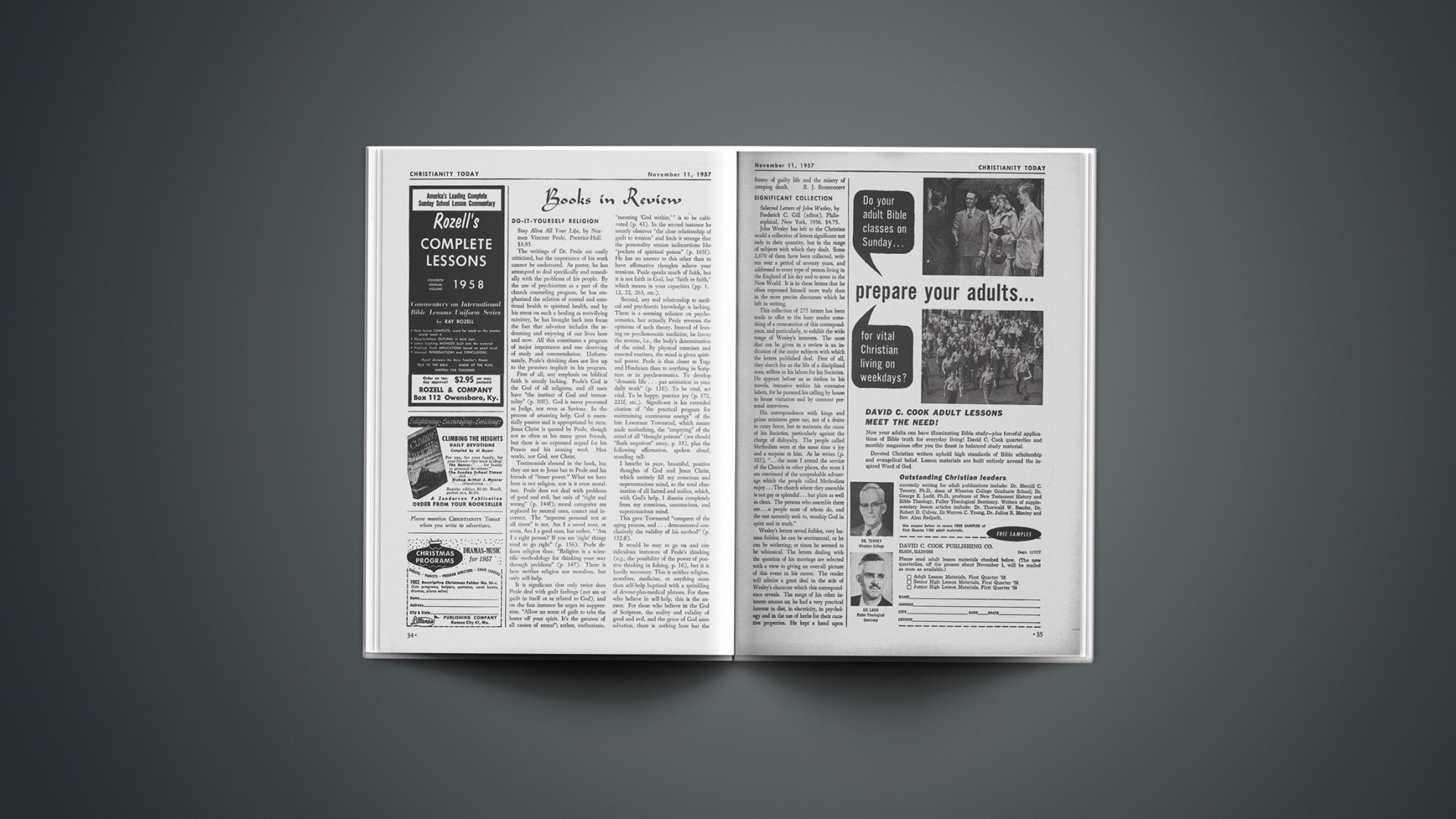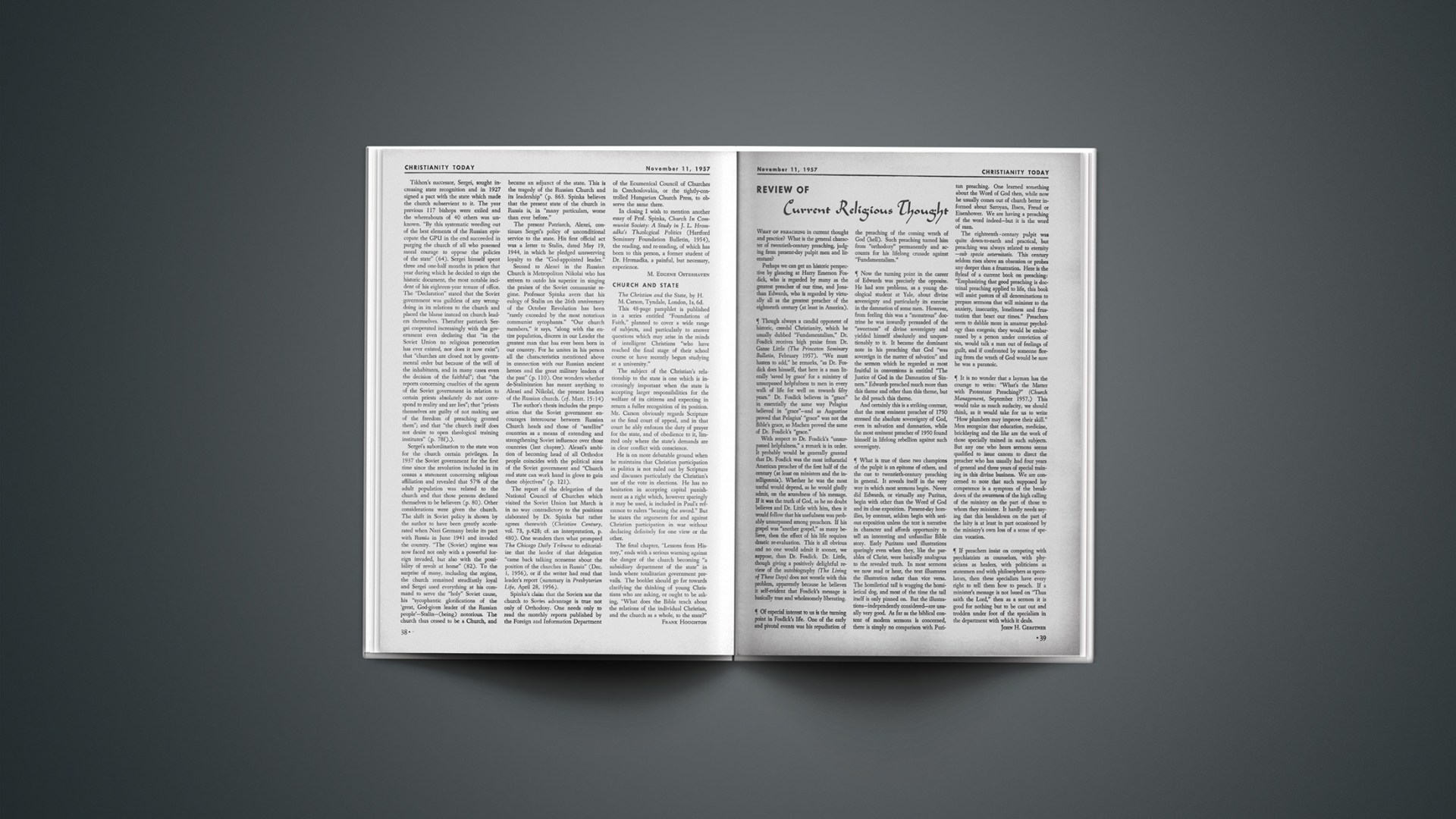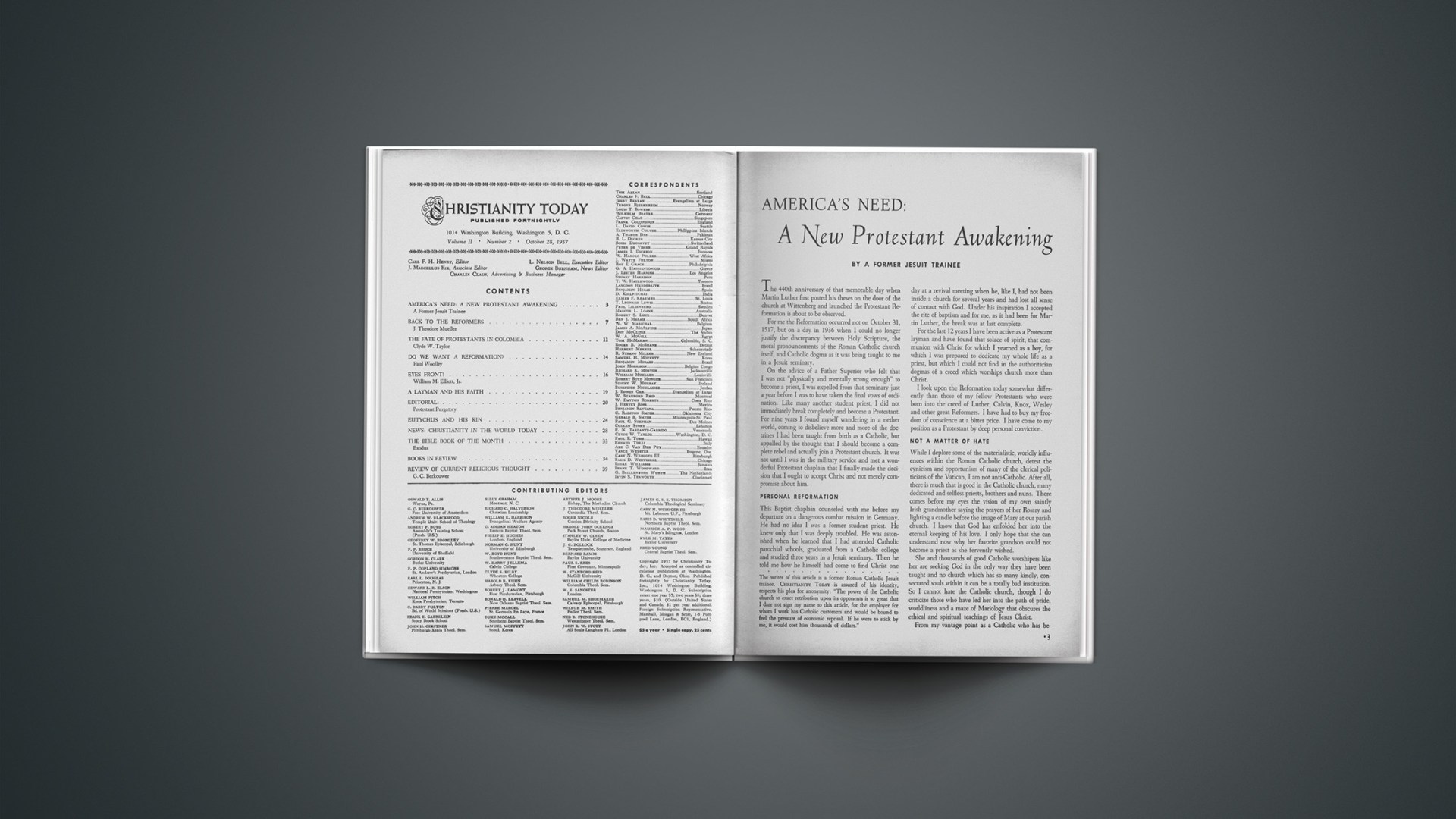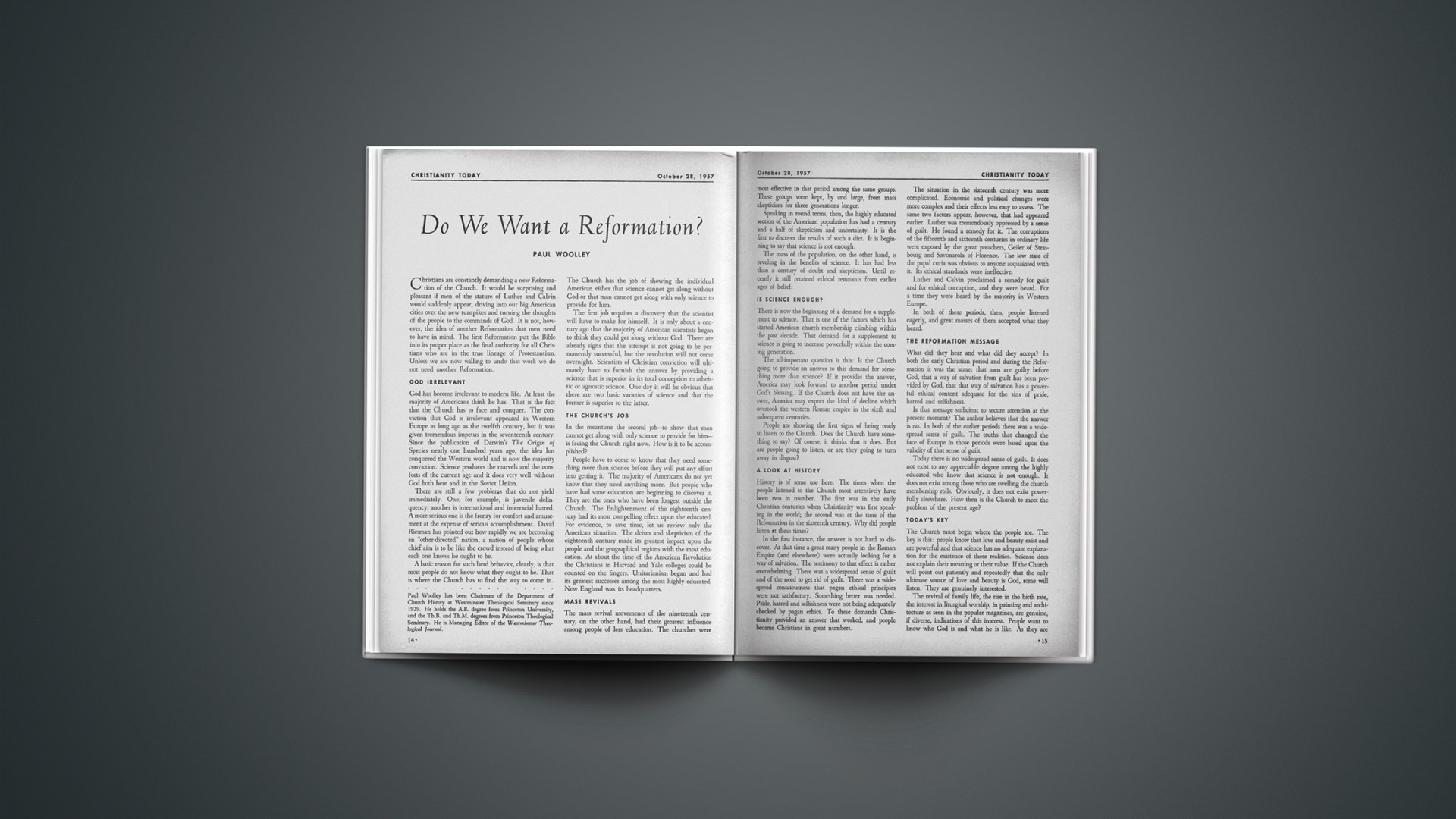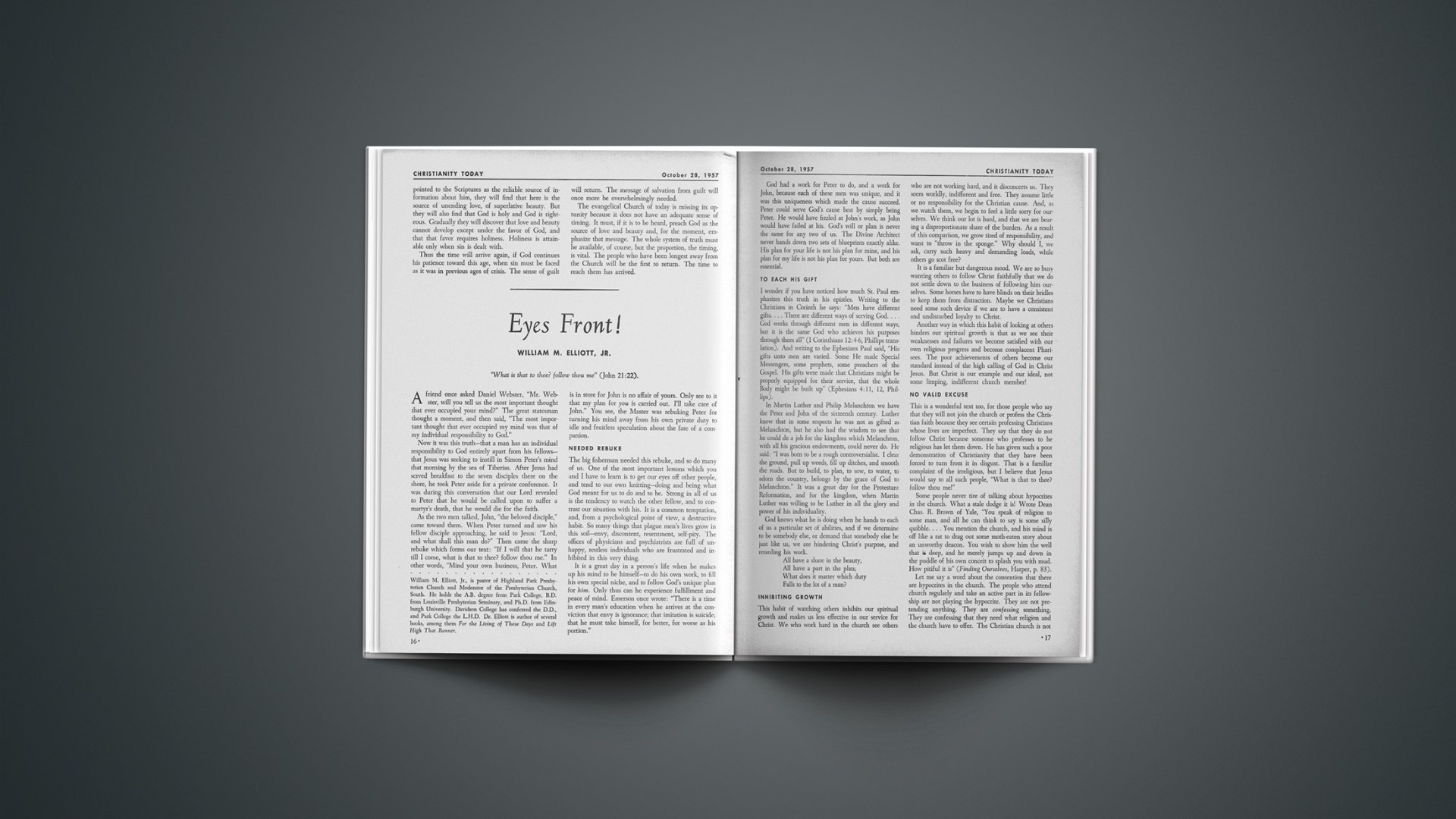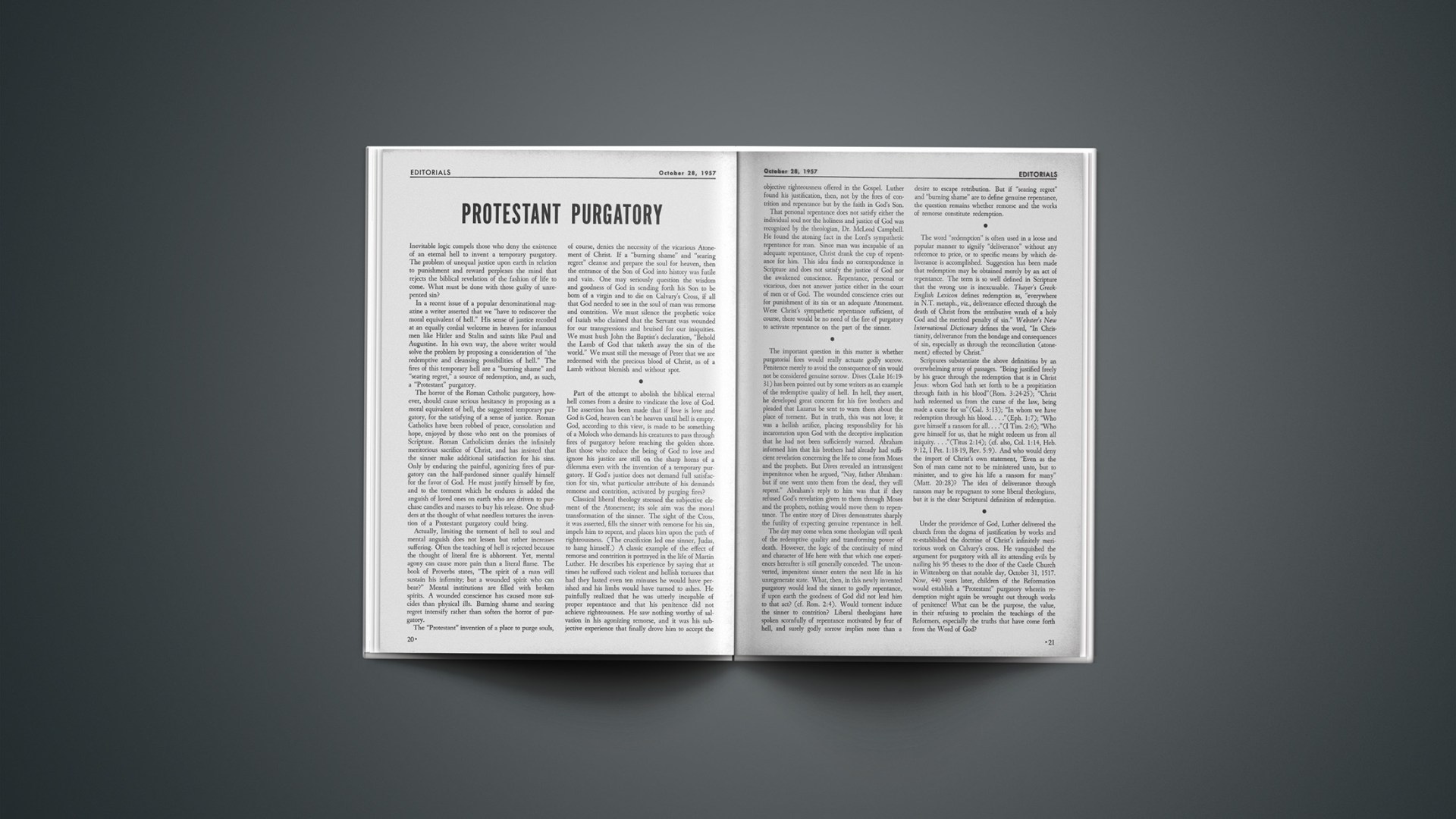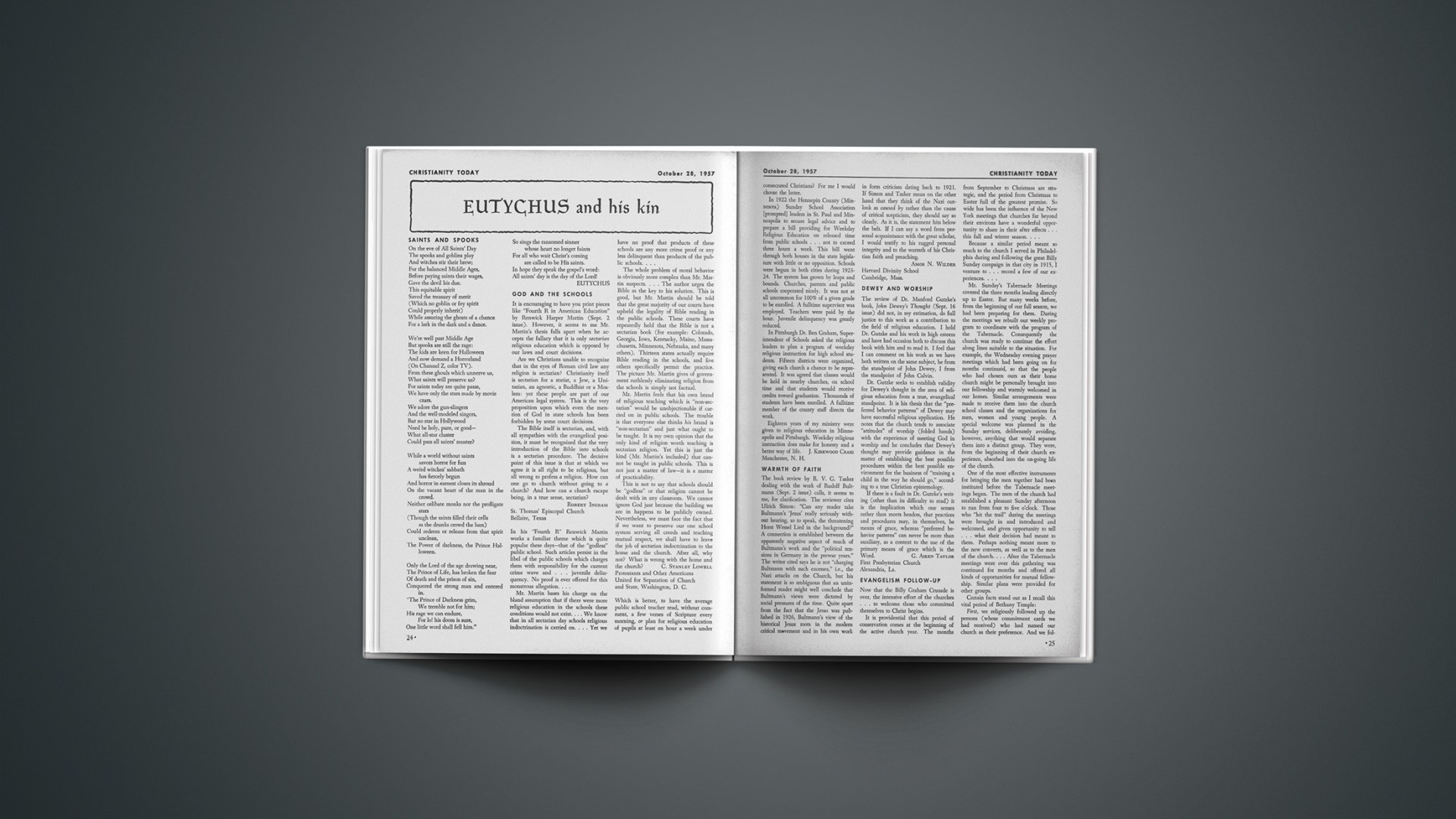Do-It-Yourself Religion
Stay Alive All Your Life, by Norman Vincent Peale, Prentice-Hall. $3.95.
The writings of Dr. Peale are easily criticized, but the importance of his work cannot be underrated. As pastor, he has attempted to deal specifically and remedially with the problems of his people. By the use of psychiatrists as a part of the church counseling program, he has emphasized the relation of mental and emotional health to spiritual health, and by his stress on such a healing as revivifying ministry, he has brought back into focus the fact that salvation includes the redeeming and enjoying of our lives here and now. All this constitutes a program of major importance and one deserving of study and commendation. Unfortunately, Peak’s thinking does not live up to the promises implicit in his program.
First of all, any emphasis on biblical faith is utterly lacking. Peak’s God is the God of all religions, and all men have “the instinct of God and immortality” (p. 300). God is never presented as Judge, nor even as Saviour. In the process of attaining help, God is essentially passive and is appropriated by men. Jesus Christ is quoted by Peak, though not so often as his many great friends, but there is no expressed regard for his Person and his atoning work. Man works, not God, nor Christ.
Testimonials abound in the book, but they are not to Jesus but to Peak and his friends of “inner power.” What we have here is not religion, nor is it even moralism. Peak does not deal with problems of good and evil, but only of “right and wrong” (p. 144f); moral categories are replaced by neutral ones, correct and incorrect. The “supreme personal test at all times” is not, Am I a saved man, or even, Am I a good man, but rather, “ ‘Am I a right person?’ If you are ‘right’ things tend to go right” (p. 156). Peak defines religion thus: “Religion is a scientific methodology for thinking your way through problems” (p. 147). There is here neither religion nor moralism, but only self-help.
It is significant that only twice does Peak deal with guilt feelings (not sin or guilt in itself or as related to God), and on the first instance he urges its suppression. “Allow no sense of guilt to take the luster off your spirit. It’s the greatest of all causes of ennui”; rather, enthusiasm, “meaning ‘God within,’ ” is to be cultivated (p. 43). In the second instance he merely observes “the close relationship of guilt to tension” and finds it strange that the personality retains indiscretions like “pockets of spiritual poison” (p. 165f). He has no answer to this other than to have affirmative thoughts relieve your tensions. Peak speaks much of faith, but it is not faith in God, but “faith in faith,” which means in your capacities (pp. 1, 12, 22, 263, etc.).
Second, any real relationship to medical and psychiatric knowledge is lacking. There is a seeming reliance on psychosomatics, but actually Peak reverses the opinions of such theory. Instead of leaning on psychosomatic medicine, he favors the reverse, i.e., the body’s determination of the mind. By physical exercises and enacted routines, the mind is given spiritual power. Peak is thus closer to Yoga and Hinduism than to anything in Scripture or in psychosomatics. To develop “dynamic life … put animation in your daily work” (p. 110). To be vital, act vital. To be happy, practice joy (p. 172, 221f, etc.). Significant is his extended citation of “the practical program for maintaining continuous energy” of the late Lawrence Townsend, which meant nude sunbathing, the “emptying” of the mind of all “thought poisons” (we should “flush negatives” away, p. 33), plus the following affirmation, spoken aloud, standing tall:
I breathe in pure, beautiful, positive thoughts of God and Jesus Christ, which entirely fill my conscious and superconscious mind, to the total elimination of all hatred and malice, which, with God’s help, I dismiss completely from my conscious, unconscious, and superconscious mind.
This gave Townsend “conquest of the aging process, and … demonstrated conclusively the validity of his method” (p. 132 ff).
It would be easy to go on and cite ridiculous instances of Peak’s thinking (e.g., the possibility of the power of positive thinking in fishing, p. 16), but it is hardly necessary. This is neither religion, moralism, medicine, or anything more than self-help baptized with a sprinkling of devout-plus-medical phrases. For those who believe in self-help, this is the answer. For those who believe in the God of Scripture, the reality and validity of good and evil, and the grace of God unto salvation, there is nothing here but the frenzy of guilty life and the misery of creeping death.
R. J. RUSHDOONY
Significant Collection
Selected Letters of John Wesley, by Frederick C. Gill (editor). Philosophical, New York, 1956. $4.75.
John Wesley has left to the Christian world a collection of letters significant not only in their quantity, but in the range of subjects with which they dealt. Some 2,670 of them have been collected, written over a period of seventy years, and addressed to every type of person living in the England of his day and to some in the New World. It is in these letters that he often expressed himself more truly than in the more precise discourses which he left in writing.
This collection of 275 letters has been made to offer to the busy reader something of a cross-section of this correspondence, and particularly, to exhibit the wide range of Wesley’s interests. The most that can be given in a review is an indication of the major subjects with which the letters published deal. First of all, they sketch for us the life of a disciplined man, selfless in his labors for his Societies. He appears before us as tireless in his travels, intensive within his extensive labors, for he pursued his calling by house to house visitation and by constant personal interviews.
His correspondence with kings and prime ministers grew out, not of a desire to curry favor, but to maintain the cause of his Societies, particularly against the charge of disloyalty. The people called Methodists were at the same time a joy and a surprise to him. As he writes (p. 105), “… the more I attend the service of the Church in other places, the more I am convinced of the unspeakable advantage which the people called Methodists enjoy … The church where they assemble is not gay or splendid … but plain as well as clean. The persons who assemble there are … a people most of whom do, and the rest earnestly seek to, worship God in spirit and in truth.”
Wesley’s letters reveal foibles, very human foibles; he can be sentimental, or he can be withering; at times he seemed to be whimsical. The letters dealing with the question of his marriage are selected with a view to giving an over-all picture of this event in his career. The reader will admire a great deal in the side of Wesley’s character which this correspondence reveals. The range of his other interests amazes us; he had a very practical interest in diet, in electricity, in psychology and in the use of herbs for their curative properties. He kept a hand upon movements of thought no less than upon trends in the religious practices of his time. Best of all, he was a man of tremendous force and unquestioned dedication.
This volume can be recommended for its balanced insight into the life and work of this cosmopolitan figure. The Editor is correct in his statement at the end of the Preface: “His letters still live, and are characteristic of the man, showing unsuspected angles of his mind, reflecting vividly the life and spirit of the age, and revealing the birth and growth of a nationwide revival …” Here is a collection of the most significant of them.
HAROLD B. KUHN
Sunday School Methods
Informal Talks on Sunday School Teaching, by Ray Rozell, Grand Rapids International Publications, distributed by Kregel’s, Grand Rapids. 160 pp., $2.00.
Do you consider yourself a capable Sunday School teacher—one who possesses knowledge concerning the technique of teaching? Read this book and you will find how much can still be learned.
Here is a book that is true to its title. It presents a wealth of plain and intensely practical hints on teaching. The meaning of teaching and the importance of knowing the pupil’s needs and the teacher’s aims, the know-how of the pupil learning process and the methods to be followed—all this and more is systematically discussed. The treatment given these matters by the pedagogically astute author is as interesting as it is extensive.
The author rightly states that it is essential that the teacher be motivated by a Christian philosophy of life. But it is at this point that we find it difficult to follow the author. His philosophy—like too much present-day Sunday School material—is off-center. Instead of being God-centered or Christ-centered, it is pupil-centered. The whole teaching program is directed to supplying pupil needs. Even the Bible is said to be a “tool” to this end. Says the author, “It is the pupil that we are teaching and not the Bible.… In all of our lesson planning and presentation we must keep the pupil at the center” (p. 33). To make the pupil central in our teaching is to teach the pupil that he is the center. To make one who is an image of God central is an affront to him of whom he is an image.
To be sure, we must analyze the needs of our pupils and seek to supply them. We also agree that teaching should be impelled by a specific aim. But just what is this need and aim? Is it the need and aim envisioned by the mother of James and John who requested Jesus that her boys might be leaders in his kingdom and share his glory? The teacher who is so minded should be told in the words of Jesus, “You know not what you ask.” To share Christ’s glory is to drink Christ’s cup of death on the cross. Not the promotion of the individual, but the daily crucifixion of this individual with Christ, is the basic need of our pupils and the fundamental aim of Christian teaching. The “I” as a center must be crucified that the resurrected Christ may be central in their lives (Gal. 2:20).
MARK FAKKEMA
Valuable Tool
The Church in Soviet Russia, by Matthew Spinka. The Oxford University Press, New York, 1956. $3.25
A problem in the world church today is that of the church in Eastern Europe. A scholar who has made a careful study of this problem is Matthew Spinka of the Hartford Theological Seminary. His thesis in the volume before us is that the Soviet state, in the early years of the Bolshevik revolution wholly antipathetic towards the church in Russia, now utilizes the church as a valuable tool for its own purposes and policies (p. 94 et al.).
A disastrous event hardly equalled in “the whole course of church history” was the resolution of the Karlovtsi conference in November, 1921, in which a large number of Russian emigre ecclesiastical leaders called upon God to overthrow the Bolsheviks and to restore the House of Romanov to the throne (p. 24ff). The revolutionary Communist leaders, remembering the earlier slavish subservience of the church to the Tsar, interpreted the resolution as further proof of reactionary church political policies and the church itself between the anvil and the hammer. In his struggle for church autonomy Tikhon, who was the first leader of the post-revolutionary church (1917–25) and became patriarch, at first fought the regime. Within a year, however, he saw that that policy could only end in defeat so he altered it to secure for his church autonomy within the state. Tikhon became convinced, especially during his imprisonment (1922) that non-interference in politics was the policy necessary for the church’s survival. The reward for this change was that the state gave him the legal right to administer the church.
Tikhon’s successor, Sergei, sought increasing state recognition and in 1927 signed a pact with the state which made the church subservient to it. The year previous 117 bishops were exiled and the whereabouts of 40 others was unknown. “By this systematic weeding out of the best elements of the Russian episcopate the GPU in the end succeeded in purging the church of all who posessed moral courage to oppose the policies of the state” (64). Sergei himself spent three and one-half months in prison that year during which he decided to sign the historic document, the most notable incident of his eighteen-year tenure of office. The “Declaration” stated that the Soviet government was guiltless of any wrongdoing in its relations to the church and placed the blame instead on church leaders themselves. Therafter patriarch Sergei cooperated increasingly with the government even declaring that “in the Soviet Union no religious persecution has ever existed, nor does it now exist”; that “churches are closed not by governmental order but because of the will of the inhabitants, and in many cases even the decision of the faithful”; that “the reports concerning cruelties of the agents of the Soviet government in relation to certain priests absolutely do not correspond to reality and are lies”; that “priests themselves are guilty of not making use of the freedom of preaching granted them”; and that “the church itself does not desire to open theological training institutes” (p. 78f).).
Sergei’s subordination to the state won for the church certain privileges. In 1937 the Soviet government for the first time since the revolution included in its census a statement concerning religious affiliation and revealed that 57% of the adult population was related to the church and that those persons declared themselves to be believers (p. 80). Other considerations were given the church. The shift in Soviet policy is shown by the author to have been greatly accelerated when Nazi Germany broke its pact with Russia in June 1941 and invaded the country. “The (Soviet) regime was now faced not only with a powerful foreign invaded, but also with the possibility of revolt at home” (82). To the surprise of many, including the regime, the church remained steadfastly loyal and Sergei used everything at his command to serve the “holy” Soviet cause, his “sycophantic glorifications of the ‘great, God-given leader of the Russian people’—Stalin—(being) notorious. The church thus ceased to be a Church, and became an adjunct of the state. This is the tragedy of the Russian Church and its leadership” (p. 863. Spinka believes that the present state of the church in Russia is, in “many particulars, worse than ever before.”
The present Patriarch, Alexei, continues Sergei’s policy of unconditional service to the state. His first official act was a letter to Stalin, dated May 19, 1944, in which he pledged unswerving loyalty to the “God-appointed leader.”
Second to Alexei in the Russian Church is Metropolitan Nikolai who has striven to outdo his superior in singing the praises of the Soviet communist regime. Professor Spinka avers that his eulogy of Stalin on the 26th anniversary of the October Revolution has been “rarely exceeded by the most notorious communist sycophants.” “Our church members,” it says, “along with the entire population, discern in our Leader the greatest man that has ever been born in our country. For he unites in his person all the characteristics mentioned above in connection with our Russian ancient heroes and the great military leaders of the past” (p. 110). One wonders whether de-Stalinization has meant anything to Alexei and Nikolai, the present leaders of the Russian church. (cf. Matt. 15:14)
The author’s thesis includes the proposition that the Soviet government encourages intercourse between Russian Church heads and those of “satellite” countries as a means of extending and strengthening Soviet influence over those countries (last chapter). Alexei’s ambition of becoming head of all Orthodox people coincides with the political aims of the Soviet government and “Church and state can work hand in glove to gain these objectives” (p. 121).
The report of the delegation of the National Council of Churches which visited the Soviet Union last March is in no way contradictory to the positions elaborated by Dr. Spinka but rather agrees therewith (Christian Century, vol. 73, p. 428; cf. an interpretation, p. 480). One wonders then what prompted The Chicago Daily Tribune to editorialize that the leader of that delegation “came back talking nonsense about the position of the churches in Russia” (Dec. 1, 1956), or if the writer had read that leader’s report (summary in Presbyterian Life, April 28, 1956).
Spinka’s claim that the Soviets use the church to Soviet advantage is true not only of Orthodoxy. One needs only to read the monthly reports published by the Foreign and Information Department of the Ecumenical Council of Churches in Czechoslovakia, or the tightly-controlled Hungarian Church Press, to observe the same there.
In closing I wish to mention another essay of Prof. Spinka, Church In Communist Society: A Study in J. L. Hromadka’s Theological Politics (Hartford Seminary Foundation Bulletin, 1954), the reading, and re-reading, of which has been to this person, a former student of Dr. Hromadka, a painful, but necessary, experience.
M. EUGENE OSTERHAVEN
Church And State
The Christian and the State, by H. M. Carson, Tyndale, London, Is, 6d.
This 48-page pamphlet is published in a series entitled “Foundations of Faith,” planned to cover a wide range of subjects, and particularly to answer questions which may arise in the minds of intelligent Christians “who have reached the final stage of their school course or have recently begun studying at a university.”
The subject of the Christian’s relationship to the state is one which is increasingly important when the state is accepting larger responsibilities for the welfare of its citizens and expecting in return a fuller recognition of its position. Mr. Carson obviously regards Scripture as the final court of appeal, and in that court he ably enforces the duty of prayer for the state, and of obedience to it, limited only where the state’s demands are in clear conflict with conscience.
He is on more debatable ground when he maintains that Christian participation in politics is not ruled out by Scripture and discusses particularly the Christian’s use of the vote in elections. He has no hesitation in accepting capital punishment as a right which, however sparingly it may be used, is included in Paul’s reference to rulers “bearing the sword.” But he states the arguments for and against Christian participation in war without declaring definitely for one view or the other.
The final chapter, “Lessons from History,” ends with a serious warning against the danger of the church becoming “a subsidiary department of the state” in lands where totalitarian government prevails. The booklet should go far towards clarifying the thinking of young Christians who are asking, or ought to be asking, “What does the Bible teach about the relations of the individual Christian, and the church as a whole, to the state?”
FRANK HOUGHTON

